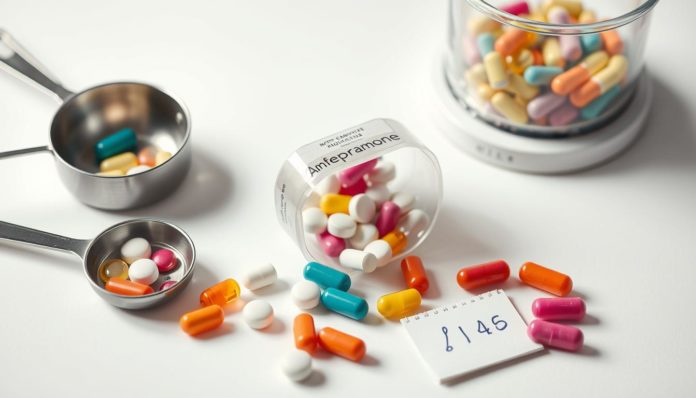In the United States, a shocking 70% of adults are overweight or obese. This makes finding effective weight loss methods very crucial. Amfepramone is a powerful anorectic drug. It is approved by the FDA for short-term weight management.
This guide gives you all the details on Amfepramone, from its uses and dosage to potential side effects. If you’re looking into this appetite suppressant for weight loss, or just want to understand its effects, this is for you. Learn how it can help when added to diet and exercise.
Introduction to Amfepramone
Amfepramone, known as Tenuate and Regenon, is a key player in weight loss. It’s a stimulant, but it’s less likely to be abused than other drugs. Doctors suggest it for people whose BMI is 30 or more.

In 1959, Amfepramone got the green light from the FDA. It’s part of a bigger plan that includes changing what you eat and exercising more. It’s meant to be a short-term help, usually for up to 12 weeks. This approach has proven to be a reliable way to fight obesity.
Diethylpropion is another name for it. It’s not just about the drug, but also about a healthy lifestyle. Exercise and diet play big roles. People using Amfepramone hydrochloride often see great benefits. It helps them manage their weight and live healthier lives.
How Amfepramone Works
Amfepramone is used mainly for losing weight. It works deep in the central nervous system. This affects important brain chemicals. Understanding how it works and its health benefits is key.
Mechanism of Action
Amfepramone acts like the body’s emergency system. It’s known as a sympathomimetic stimulant. When taken, it causes the “fight-or-flight” response. This leads to less hunger.
This response releases certain neurotransmitters like norepinephrine and serotonin. They help control hunger. This makes it easier to eat less and manage weight better.

Therapeutic Effects
Amfepramone does more than just curb hunger. It also helps the body burn calories better. This helps a lot in losing weight. It also balances brain chemicals for better appetite control.
Uses of Amfepramone
Amfepramone is often chosen for treating obesity, especially in adults who find losing weight tough. Doctors recommend it for those with a high body mass index (BMI). This treatment, approved by the FDA, targets Class 1, 2, or 3 obesity.
Weight Management
For weight management, Amfepramone plays a key role. It reduces hunger, helping users eat less and stick to their diet plans. This medicine is great for those needing major weight loss. It has been proven to speed up losing weight, helping people meet health goals quicker.
Combination with Diet and Exercise
Amfepramone works best when paired with diet and exercise. This blend ensures lasting weight loss success. Doctors say it’s critical to follow a diet plan and stay active for the best results.
| Component | Description | Impact |
|---|---|---|
| Amfepramone | Weight loss medication | Reduces appetite, facilitating lower caloric intake |
| Diet Changes | Structured and balanced eating plan | Enhances the effectiveness of amfepramone |
| Regular Exercise | Consistent physical activity routine | Supports accelerated weight loss and BMI reduction |
Recommended Dosage for Amfepramone
Knowing the right amount of Amfepramone to take is key for it to work safely and well. This drug comes in different forms like immediate-release tablets and extended-release ones. Each form has its own way of being taken.
Immediate-Release Tablets
Immediate-release tablets are usually taken an hour before you eat. For adults and those 17 and up, the usual amount is 25 mg three times a day. Taking these tablets before meals makes Amfepramone work better.
Extended-Release Tablets
If you need the drug to work longer, extended-release tablets are good. You take them once a day, often in the mid-morning. They should be 75 mg each. Remember, don’t break, crush, or chew them. This keeps them working right.
Missed Dose
If you forget a dose, take it when you remember. But, if your next dose is soon, skip the one you missed. This avoids taking too much. It’s important for keeping the right amount in your body and lowering risks.
| Dosage Form | Standard Dosage | Administration Time |
|---|---|---|
| Immediate-Release Tablets | 25 mg three times daily | An hour before meals |
| Extended-Release Tablets | 75 mg once daily | Mid-morning |
Side Effects of Amfepramone
Amfepramone, like all medications, has side effects. It’s key for users to know these potential problems. They should watch for both common and serious side effects. Plus, knowing overdose symptoms is vital.
Common Side Effects
Common side effects of Amfepramone can include:
- Dizziness
- Dry mouth
- Restlessness
- Gastrointestinal distress
- Insomnia
These symptoms are usually mild but annoying. If they don’t go away, talking to a doctor is important.
Serious Side Effects
Some side effects of Amfepramone are more serious. They need quick medical help. These include:
- Palpitations
- Increased blood pressure
- Chest pain
- Difficulty breathing
- Swelling of extremities
- Vision changes
- Allergic reactions
If you have any of these serious side effects, stop taking the drug. Then, get emergency help right away.
Overdose Symptoms
Symptoms of an overdose on Amfepramone can be severe. They might include:
- Confusion
- Diarrhea
- Restlessness
- Stomach cramps
- Sweating
- Vomiting
In case of an overdose, getting medical help fast is crucial. This quick action can stop symptoms from getting worse. It also keeps the patient safe.
Contraindications and Precautions
Before using Amfepramone, one must know the contraindications and safety measures. This ensures the treatment is both safe and effective.
Pre-existing Conditions
People with certain pre-existing conditions should not take Amfepramone. These conditions include past heart problems, high blood pressure that’s not under control, and allergy to sympathomimetic amines. People with diabetes also need to be careful. This is because Amfepramone might change sugar levels and hide low sugar symptoms.
Drug Interactions
It’s important to know drug interactions if you’re considering Amfepramone. Mixing it with monoamine oxidase inhibitors (MAOIs) could lead to serious heart trouble and high blood pressure. Always talk with your healthcare provider about your current meds to steer clear of harmful drug interactions.
| Condition/Interaction | Details |
|---|---|
| Cardiovascular Disease | Individuals with heart diseases should avoid Amfepramone. |
| Uncontrolled Hypertension | High blood pressure patients should not use this medication. |
| Hypersensitivity | Avoid if allergic to sympathomimetic amines. |
| Diabetes | Monitor blood sugar levels closely. |
| Monoamine Oxidase Inhibitors (MAOIs) | Do not use with MAOIs to prevent hypertension risks. |
Storage Instructions
Keeping medication like Amfepramone stored correctly is key for its effectiveness. These tablets need to stay in a container that’s closed. They should be at room temperature. It’s important to protect them from too much heat, moisture, and light. Never freeze the tablets as it can ruin their quality.
When it comes to medication storage, safety is crucial. Keep Amfepramone out of kids’ reach to avoid accidental swallowing. Safe storage goes hand in hand with proper medicine disposal. Dispose of old or unused meds the right way. Ask healthcare professionals how. This keeps you safe and helps the environment too.
| Storage Element | Instruction |
|---|---|
| Container | Keep closed |
| Temperature | Room temperature |
| Protection | Avoid excess heat, moisture, light |
| Freezing | Avoid |
| Child Safety | Store out of children’s reach |
| Disposal | Follow healthcare professional’s guidance |
Amfepramone for Weight Loss
Amfepramone, also called diethylpropion, plays a big role in losing weight. This FDA-approved weight loss drug helps mainly for short-term control of weight. It works best with a lower-calorie diet and regular workouts.
Studies have shown that Amfepramone is effective in helping people lose weight. In these studies, participants lost a lot of weight. This proves the drug works well when you also eat right and exercise. Amfepramone is meant to be used for no more than 12 weeks.
If taken as directed, people can see a big drop in weight. The mix of medication, diet, and exercise offers a steady way to manage weight. Its success and safe use show it’s a good option for getting to a healthy weight.
FDA Approval and Regulatory Status
Learning about Amfepramone’s journey through regulation helps us understand its trustworthiness and how to use it properly. It got FDA approval back in 1959. This was a big deal because it was one of the first drugs approved for battling obesity. Its approval highlighted its effectiveness and safety for patients, under doctors’ care.
History of Approval
The story of how Amfepramone was approved by the FDA shows many years of use and scientific study. It was initially approved for short-term use. Studies well document its help in weight loss. Through time, its safety and performance have been closely watched, maintaining it as an option for those fighting obesity. The approval helped make drugs a part of the fight against obesity.
Current Regulatory Guidelines
Nowadays, rules say Amfepramone should be used briefly, usually no more than three months. This aligns with modern advice on treating obesity, suggesting that diet and exercise should accompany the medication. Doctors can prescribe it for longer, but they must be very careful. They need to watch the patient’s health closely to avoid any risks from long-term use.
Following these rules makes sure Amfepramone stays a secure and effective choice in treating obesity, keeping its position among prescription drugs.
FAQ
What is Amfepramone?
Amfepramone, known too as diethylpropion, has FDA approval. It lowers hunger to help with short-term weight loss, alongside diet and exercise. You can find it in two tablet forms: immediate-release and extended-release.
How does Amfepramone work?
This drug works by acting on the brain. It’s a stimulant that releases certain chemicals to control hunger. This can lead to less eating and more calorie burning, helping in weight loss.
What is the recommended dosage for Amfepramone?
Dosage depends on the tablet type. For immediate-release, it’s usually 25 mg three times a day. Extended-release tablets are 75 mg once daily. Always follow your doctor’s advice.
What are the common side effects of Amfepramone?
Some may feel dizzy, have a dry mouth, feel restless, experience stomach issues, or have trouble sleeping. While mild, these effects should be watched.
Can I purchase Amfepramone online?
Yes, buying Amfepramone online is an option. But, it’s important to be cautious and use trusted sources. Ensure you have a valid prescription from a doctor.
Are there any serious side effects associated with Amfepramone?
Yes, some serious side effects exist. They include heart palpitations, high blood pressure, chest pain, breathing troubles, swelling, changes in vision, and allergic reactions. Seek medical help right away if you experience these.
What should I do if I miss a dose?
If you forget to take a dose, take it as soon as you can. If it’s nearly time for the next one, skip it. Don’t take extra to catch up.
What are the contraindications for using Amfepramone?
Don’t use it if you have certain heart conditions, very high blood pressure, or allergies to similar meds. Also, talk to your doctor about other medications you’re taking, like monoamine oxidase inhibitors.
How should Amfepramone be stored?
Keep it at room temperature, in a dry place, away from too much heat and light. Make sure kids can’t reach it. Dispose of it properly if not needed anymore.
What is the role of Amfepramone in weight loss?
It’s meant for short-term help, paired with a low-calorie diet and exercise. It’s for those struggling with obesity, needing extra help beyond diet and exercise. It’s usually used for up to 12 weeks.
When was Amfepramone first approved by the FDA?
The FDA gave its approval in 1959. Its long approval time shows its effectiveness and safety for short-term weight management.
What are the current regulatory guidelines for Amfepramone?
It’s approved for short use, about 12 weeks, with diet and exercise for managing obesity. Doctors might prescribe it longer, depending on the patient’s situation and how they respond.


